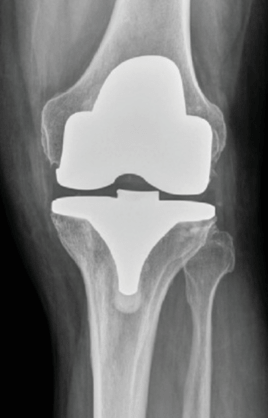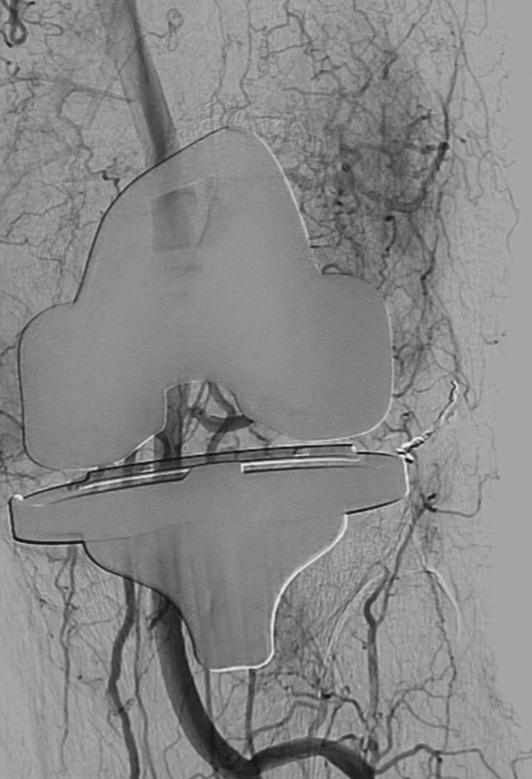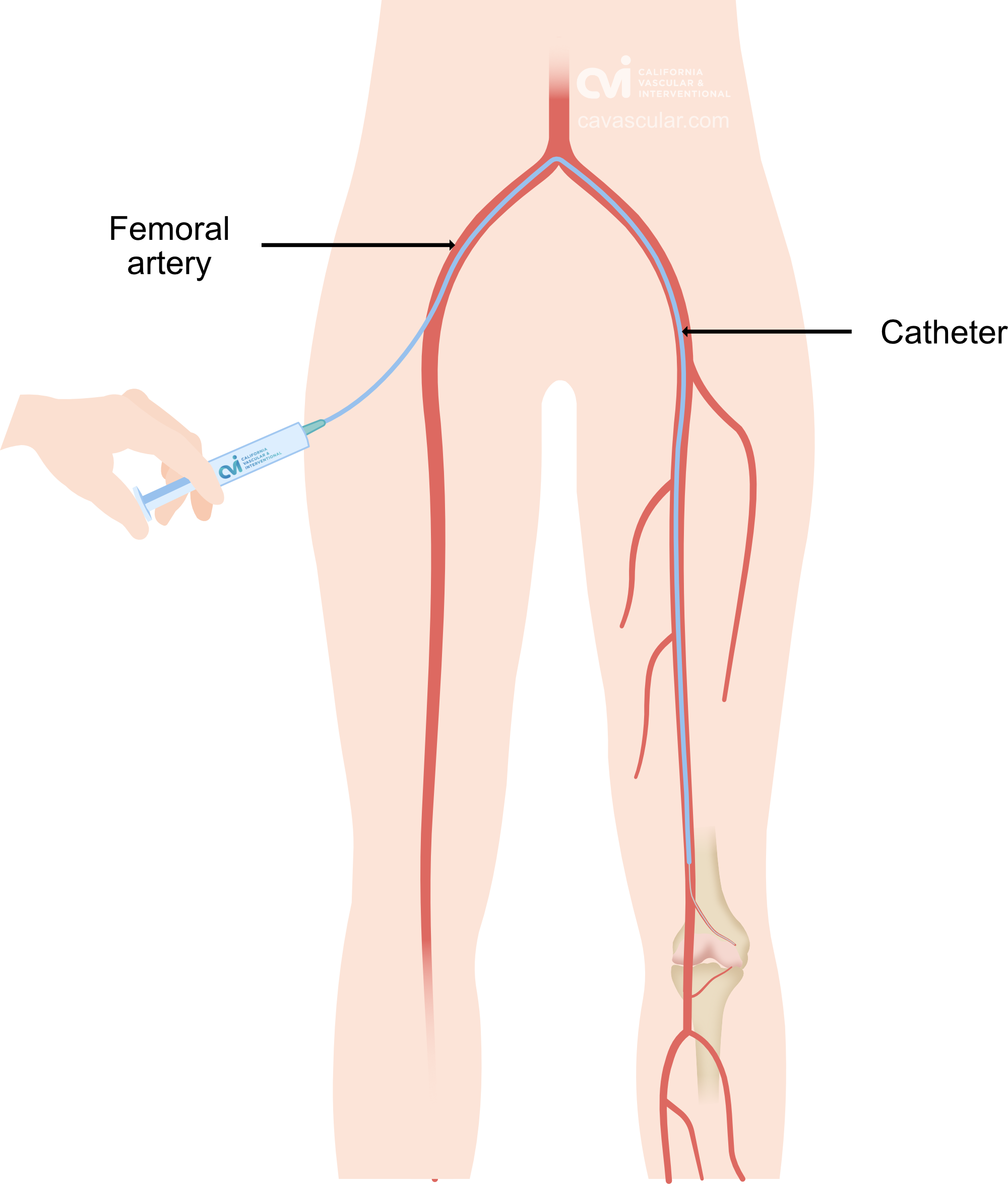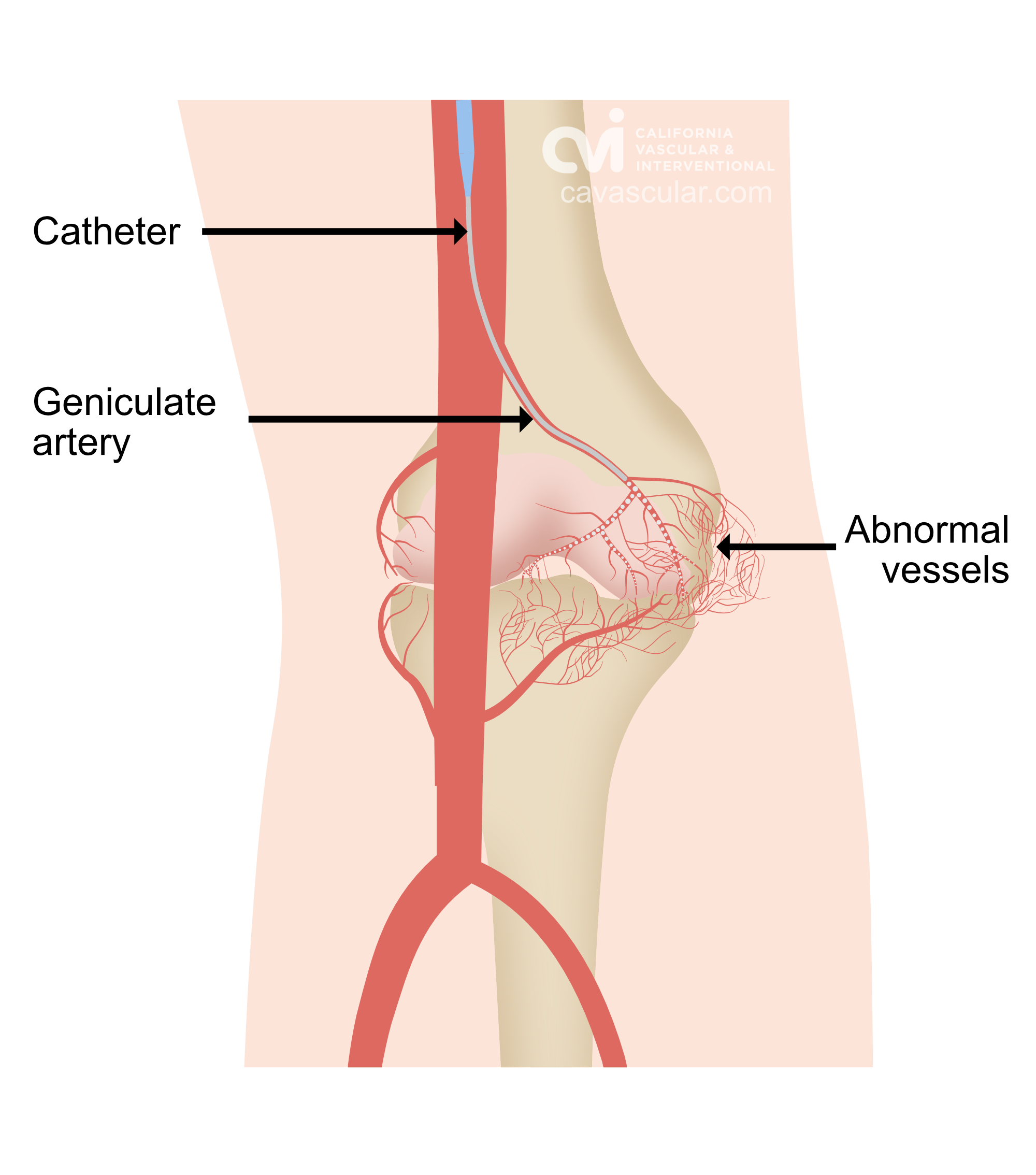
Virtual remote appointments are available. Contact us for a video telehealth evaluation.

All appointments conducted by our Board Certified doctor and not assistants or non-physician providers.
Geniculate Artery Embolization for Osteoarthritis
You have likely been told surgery or medication are the only options for osteoarthritis. However, recent research and advancement has found that a non-surgical treatment option called geniculate artery embolization can offer a highly effective and long-lasting relief from chronic joint disease.
Osteoarthritis
Osteoarthritis (OA) refers to the inflammation of joints (arthritis) along with wear and tear of the overlying cartilage. Cartilage, a type of connective tissue, provides a cushion in the joint allowing for frictionless movement. OA affects around 32.5 million adults in the United States every year. In most people, it presents as a chronic medical condition involving the joints in the knee, hands, elbow, and spine.1,2

Causes of Osteoarthritis
Osteoarthritis is caused by the loss of the protective cartilage of the joint. When the cartilage is gone, bone will rub on bone. Certain risk factors are associated with an increased incidence of osteoarthritis. These factors include:
- Joint overuse – overusing joint e.g., running a lot without proper rest can stratify the risk
- Older age
- Gender – women are more likely to develop osteoarthritis, especially after 50. This is partly due to a post-menopausal decrease in estrogen levels.
- Being overweight – extra weight puts your joint under excessive stress and increases the wear and tear of the joint.
- Family history – having an immediate family member with OA also amplifies the risk of you having OA
- Race – certain Asian populations have a lower risk of developing osteoarthritis.2
Should Osteoarthritis be Treated?
Osteoarthritis is a chronic (long-term) condition that is often painful. Other symptoms of OA include swelling, joint stiffness, and decrease range of motion. Untreated or undertreated OA leads to severe worsening joint pain and immobility.3
Osteoarthritis Treatment Options
Osteoarthritis, unfortunately, does not have a permanent cure. The first strategy is to avoid the risk factors precipitating OA. Secondly, the treatment regimens for osteoarthritis include symptomatic treatment combined with various therapies to decrease the progression of osteoarthritis. Treatment options include:2,4
- Physical therapy
- Ice packs for swelling
- Heating pad for reduction of pain
- NSAIDs like ibuprofen for reducing pain
Persistent and painful osteoarthritis along with movement disabilities warrants surgical repair. Some surgical options for OA include: 4
- Arthroscopy
- Cartilage repair
- Osteotomy
- Arthroplasty

You have likely been told only the above are your options for osteoarthritis. However, recent research and advancement has found that a non-surgical treatment option called genicular artery embolization can offer a highly effective and long-lasting relief from chronic joint disease.5
Non-Surgical Geniculate Artery Embolization for Osteoarthritis
Surgery is often reserved for advanced cases or may not be ideal for every patient due to the length of recovery and surgical risks. Non-surgical embolization could be a potential treatment option is such a scenario.
Embolization has been around for decades and has successfully been used as a treatment option for many ailments including cancer, life threatening bleeding, big prostates, fibroids, and other vascular abnormalities. Genicular artery embolization (GAE) is a minimally invasive, novel approach that applies the same technique for the treatment of osteoarthritis. As the name suggests, GAE works by embolizing (or blocking) small arteries thus reducing the blood flow to the inflamed joint. Much of the pain experienced in osteoarthritis comes from abnormal blood vessels that form in the lining of the joint. Reducing blood flow helps reduce inflammation and subsequently diminishes the pain caused by inflammation.6
The procedure was originally designed for the symptomatic treatment of hemarthrosis; a condition characterized by bleeding into the joint after knee surgery. Currently, GAE is not a standardized treatment option for OA but an increasing number of studies are indicating the usefulness of this procedure.

Clinical studies have shown that there is a significant decrease in pain and osteoarthritis post GAE. Moreover, the need for analgesics (painkillers) was decreased. The studies also reported no serious side effects or complications during or after the procedure.7
You should seek the expert advice of your orthopedic surgeon and an interventional radiologist to further understand your options and expected outcomes.
Our outpatient center sees patients throughout Southern California including Los Angeles, Orange County and San Diego. The fibroid treatment is performed by our Endovascular Physician (an Interventional Radiologist) who is board certified in image-guided procedures using X-rays, tiny catheters and other micro-tools, and has performed thousands of complex embolizations.
What is Interventional Radiology? This is the only specialty in medicine specifically trained to perform embolization procedures, such as for hemarthrosis. Read more here.
GAE - What to Expect
Geniculate artery embolization is an outpatient non-surgical procedure with minimal downtime. The procedure is done in an outpatient state of the art center where our interventional radiologist performs the treatment through a tiny tube called a catheter. This procedure can be performed by placing the catheter in an artery at the top of the leg (called a femoral approach).
The patient is given a local and topical anesthetic to numb the skin and a mild sedative, so that the procedure is not painful. A sophisticated X-ray machine that creates moving pictures in “real” time enables the doctor to see the catheter as it is guided through the blood vessels and into the geniculate artery.
The final step in geniculate artery embolization is the injection of tiny particles the size of sand particles through the catheter. The particles lodge in the blood vessels bleeding into the joint and cut off their blood supply. By blocking or reducing the blood flow to the affected joint, this results in reduction in the inflammation and swelling.8,9

Patients are discharged 1-2 hours after the procedure and pain relief usually occurs after two weeks. As the procedure is minimally invasive, the incidence of any complications is very low. Patients might experience bruising or pain at the injection site. Some rare complications for GAE include allergic reactions, infection, bleeding/bruising, skin irritation.10
Results of Osteoarthritis GAE
Current data shows promising results in relieving osteoarthritis. A 12-month-long study showed that there was a decrease of 61% and 67% in WOMAC and pain (assessed by VAS) scores, respectively.5
Why choose CVI?
Our center specializes in embolizations, and our staff is uniquely trained to care for these types of procedures, from the pre-op to the post-op period. Our specialist performs a high number of embolization for not only the knee but also in other more high risk and complex organs, such as the kidney, liver, lung, uterus, prostate and others. Patients are often surprised how quick and simple the procedure was for them, but this comes at the experience of our specialist who performs a variety of complex embolizations safely. This diversity of experience has resulted in our specialist to treat complex cases safely and effectively.
Our specialist continually keeps up with the research to make sure that he brings the best and newest technology and technique to our center. We are also always collecting feedback from patients and modifying how we provide care so that patients have the best level of experience.
What do you need to do next? Request an appointment to meet with our embolization doctor who will review your imaging, labs and history to determine if you are candidate for the procedure, and the outcomes you can expect.
Appointments are available via an online video telehealth platform or in person at one of the offices in Los Angeles, Orange County or San Diego, depending on the doctor’s availability. Contact Us Today. Why should you choose us? Read here.
References:
- Osteoarthritis – Symptoms and causes – Mayo Clinic. Accessed March 2, 2022. https://www.mayoclinic.org/diseases-conditions/osteoarthritis/symptoms-causes/syc-20351925
- Osteoarthritis (OA) | Arthritis | CDC. Accessed March 2, 2022. https://www.cdc.gov/arthritis/basics/osteoarthritis.htm
- Osteoarthritis | National Institute on Aging. Accessed March 2, 2022. https://www.nia.nih.gov/health/osteoarthritis
- Rönn K, Reischl N, Gautier E, Jacobi M. Current surgical treatment of knee osteoarthritis. Arthritis. 2011;2011:1-9. doi:10.1155/2011/454873
- Padia SA, Genshaft S, Blumstein G, et al. Genicular Artery Embolization for the Treatment of Symptomatic Knee Osteoarthritis. JB & JS open access. 2021;6(4). doi:10.2106/JBJS.OA.21.00085
- Heller DB, Beggin AE, Lam AH, Kohi MP, Heller MB. Geniculate Artery Embolization: Role in Knee Hemarthrosis and Osteoarthritis. Radiographics. 2022;42(1):289-301. doi:10.1148/RG.210159/ASSET/IMAGES/LARGE/RG.210159.VA.JPEG
- Torkian P, Golzarian J, Chalian M, et al. Osteoarthritis-Related Knee Pain Treated With Genicular Artery Embolization: A Systematic Review and Meta-analysis. Orthopaedic journal of sports medicine. 2021;9(7):23259671211021356. doi:10.1177/23259671211021356
- van Zadelhoff TA, Moelker A, Bierma-Zeinstra SMA, Bos PK, Krestin GP, Oei EHG. Genicular artery embolization as a novel treatment for mild to moderate knee osteoarthritis: protocol design of a randomized sham-controlled clinical trial. Trials. 2022;23(1):1-8. doi:10.1186/S13063-021-05942-X/TABLES/1
- Society of Interventional Radiology – SIR 2021 knee pain. Accessed March 2, 2022. https://www.sirweb.org/media-and-pubs/media/news-release-archive/sir-2021-knee-pain-031621/
- Geniculate Artery Embolization for the Treatment of Knee Pain Secondary to Osteoarthritis NCT number NCT02850068. Published online 2017.
The above information explains what is involved and the possible risks. It is not meant to be a substitute for informed discussion between you and your doctor, but can act as a starting point for such a discussion.
